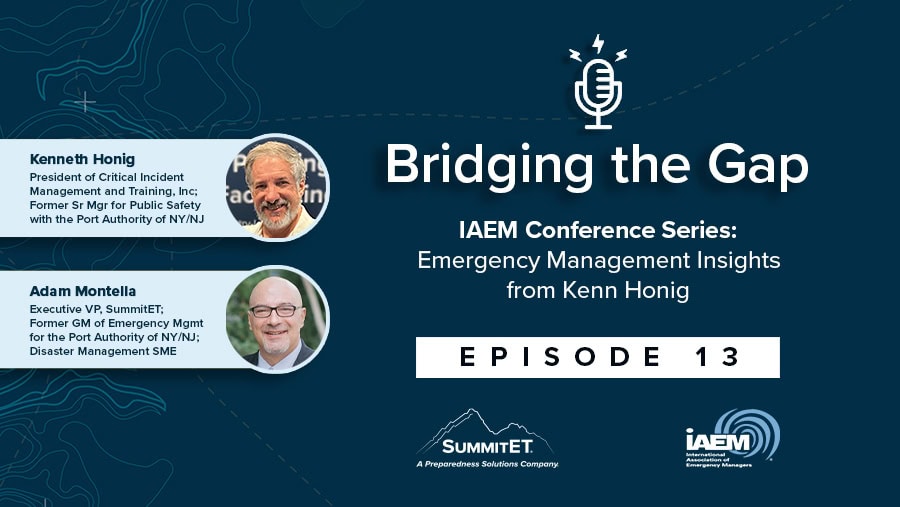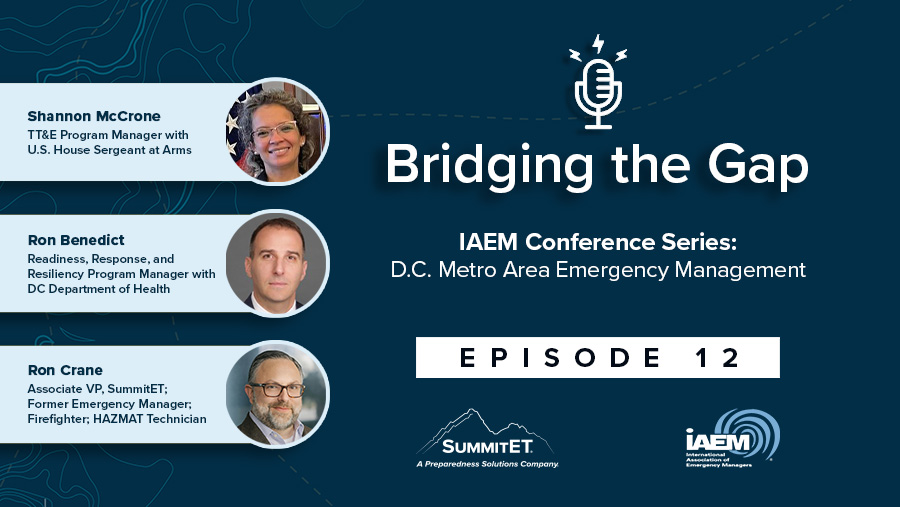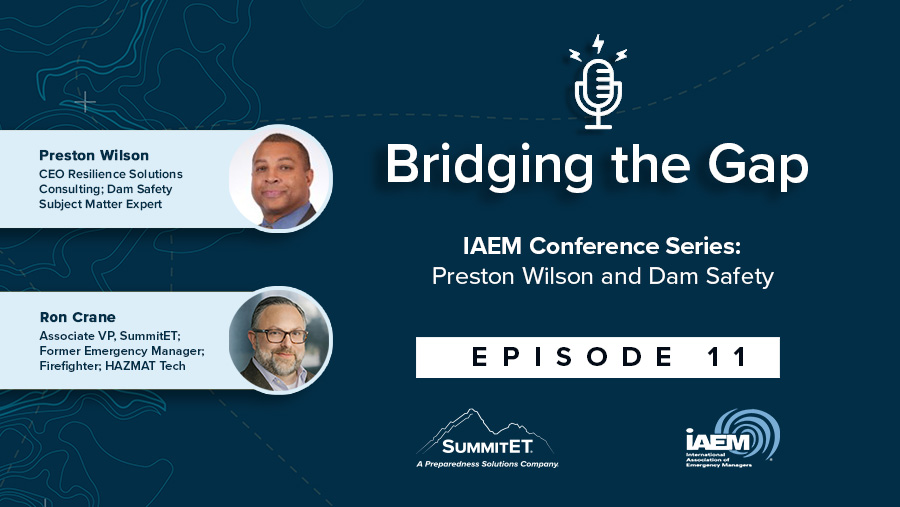SummitET Subject Matter Experts and Guest Dan Noah from the National Weather Service discuss business continuity as it relates to the emerging threat referenced in the news video: “Hurricane Outlook Predicts An Explosive 2024 Atlantic Season.”
Weather.com, May 25, 2024

In this episode of Bridging the Gap, disaster preparedness experts discuss business continuity planning for natural disasters, emphasizing the importance of including all stakeholders, from employees to the CEO, as well as local and federal government.
Business continuity helps businesses maintain operations during disruptions like natural disasters, cyber attacks, or power outages. It ensures minimal downtime and continued service delivery. Business continuity planning (BCP) is crucial and should cover all processes, assets, and personnel, with plans developed in advance involving key stakeholders.
National Weather Storm Predictions Increase
This year, Colorado State University (CSU) is forecasting 23 hurricanes originating from the Saraha Desert; the National Oceanic and Atmospheric Administration (NOAA) is forecasting 21. Not only are storm predictions higher than usual, but they are expected to push into the Gulf of Mexico and up the East Coast rather than out in the Atlantic Ocean.

Many states have experienced severe storms with flooding, hail and wind damage over the winter and early spring months throughout the U.S. As of June 2024, there have been multiple confirmed natural disaster events. According to recent reports, global natural disasters caused an estimated $43 billion in economic loss in the first quarter of 2024.
With such major economic impacts, organizations that are prepared will be in a better position to handle the hazards, but what can be done to ensure the least possible capital and human loss?
“What can companies do to ensure the least possible capital and human loss during a natural disaster?“
Weather Notification System and Communication Channels
The wireless emergency alert system on modern cell phones is one of the most effective methods for delivering warnings. It can reach you anywhere, including at home or on the road. Having multiple ways to receive weather warnings is essential for ensuring safety, especially during severe weather events when technology can fail. Here are some methods you can use:
Wireless Emergency Alerts (WEA): These are emergency messages sent by authorized government alerting authorities through your mobile carrier. They include extreme weather warnings, local emergencies requiring evacuation or immediate action, AMBER alerts, and Presidential Alerts during a national emergency. You can learn about these alerts and more from the Department of Homeland Security.
Weather Apps and Websites: There are numerous weather apps and websites that provide real-time updates and alerts about severe weather conditions, and most of them allow users to customize alerts based on location.
NOAA Weather Radio: NOAA Weather Radio broadcasts 24/7 weather information directly from the nearest National Weather Service office.
Social Media or News Outlets: Following local news outlets and meteorologists on social media platforms like Twitter and Facebook can provide timely updates and warnings during severe weather events.
Sirens and Public Address Systems: These are especially important for people who are outdoors and do not have access to a cell phone or other warning methods.
Community Alert Systems: Some communities have their own alert systems that send notifications via various channels to residents in severe weather or other emergencies.
Organizational Preparedness for Natural Disasters
Despite the resources and infrastructure available to larger organizations, there are often still gaps in preparedness. Sometimes, larger companies may become complacent, especially if they haven’t experienced a significant emergency in a long time.
Other reasons for the lack of preparedness may include:
Complexity: Large companies often have complex organizational structures, which can make it challenging to ensure that all departments and employees are adequately trained and informed.
Resources: Emergency preparedness requires resources including time, money, and personnel. Companies may prioritize other areas of operation over emergency preparedness, leading to gaps in response capabilities.
Testing: Even if emergency plans exist, they must be regularly tested or updated to ensure employees know how to respond effectively during an actual emergency.
Communication: Some companies struggle with effective communication during emergencies, particularly if they have multiple locations or a dispersed workforce. Ensuring that communication systems are robust and reliable can be a significant challenge.
Regulatory Compliance: While there may be regulations in place requiring companies to have emergency plans, compliance doesn’t always guarantee effectiveness. Internal communications plans and involving everyone in the policy and procedures is necessary to ensure the safety of all team members.
To address these challenges and avoid long-term economic impact of disasters, organizations should regularly review and update emergency plans.
Emergency Plans for Natural Disasters
When developing disaster plans, organizations should prepare for the worst-case scenario. Consider the most challenging disaster in terms of size, scope, time of year, and time of day, then plan for an even more severe event. These plans can be adapted and reused for diverse types of emergencies. For example, hurricane planning often prioritizes locating shelters to be used by the affected communities which can also be used for other types of disasters as well.
Here are some ways you can begin your organization’s disaster planning:
Risk Assessment: Identify the types of natural disasters most likely to affect your region(s) or industry. This could include hurricanes, earthquakes, floods, wildfires, tornadoes, etc. Assess the potential impact of each type of disaster on your organization’s operations, infrastructure, and personnel.
Emergency Response Plan: Create a detailed emergency response plan that outlines specific actions to be taken before, during, and after a natural disaster. This plan should include evacuation procedures, shelter-in-place protocols, communication strategies, and designated roles and responsibilities for employees.
We recommend you also collaborate with local emergency management like first responders, allowing your organization to create more realistic and effective response strategies. This collaboration can provide valuable resources and support during a natural disaster and help streamline response efforts.
Organizational Engagement: Having an emergency plan is great; however, it’s crucial to involve all levels of the organization in the planning process. This helps to ensure everyone is prepared for the disaster and allows for more insightful planning. For example, custodial and maintenance staff often have a deeper understanding of a building’s intricacies and potential issues than the CEO does, and they may provide valuable input for emergency planning procedures.
Communication Plans and Protocols: Build and implement robust communication protocols to ensure timely dissemination of information before, during, and after a natural disaster. This may involve setting up an emergency notification system, establishing communication chains, and providing employees with multiple channels for receiving updates and instructions.
Individual Family Plans: A thorough disaster plan should also include family disaster education for employees. Prioritizing the well-being and safety of staff and their families during a disaster will help ensure that they can continue their work for the organization. All disasters are local.
FEMA’s latest National Preparedness Report indicated that there are “ongoing individual and household preparedness gaps.” Only 42 percent of respondents plan to prepare for identified threats and hazards in the future but have not started, and the percentage of survey participants indicating they did not intend to prepare decreased from 17 percent in 2017 to 9 percent in 2020 but rebounded to 14 percent in 2022. People are experiencing fatigue from preparing for emergencies and disasters.
For more information on how to prepare yourself and your family visit https://ready.gov/be-informed.
Backup Systems and Redundancies: Invest in backup systems and redundancies to minimize the impact of natural disasters on critical operations. This could include backup power generators, redundant data storage systems, and alternative communication channels.
Supply Chain Management: Assess the vulnerability of your supply chain to natural disasters and develop contingency plans to mitigate risks. This could involve diversifying suppliers, stockpiling essential materials, and establishing alternative transportation routes.
Infrastructure Preparedness: Implement measures to enhance the resilience of your facilities to natural disasters. This could include retrofitting buildings to withstand high winds or earthquakes, installing flood barriers, and securing loose objects that could become projectiles in high winds.
Community Engagement: While we expect local and federal governments to maintain robust emergency operations centers, these often aren’t large enough to handle major disasters alone. Prioritizing community disaster education and collaborating with community partners during the planning process significantly enhances disaster response efforts. Many communities are now creating Business Emergency Operations Centers (BEOCs) which highlight the importance of private-public partnerships.
For example, following a disaster, grocery stores play a crucial role in helping the community return to normal. By quickly restoring essential services such as grocery, telecommunications, and banking, a community’s recovery time can be substantially reduced. When these businesses are included in disaster planning, they become integral to community preparedness efforts, allowing the government to be reimbursed for related planning expenses.
Review and Exercise Plans: Regularly review, update and exercise your emergency response plans based on lessons learned from drills, real-world incidents, and changes in your organization or operating environment.
The Importance of Experience: Experience plays a significant role in our preparedness activities. While preparedness is sometimes driven by organizational requirements or regulatory compliance, it is often shaped by past experiences. In hurricane-prone areas, small businesses near the water, which are susceptible to flooding, are typically well-versed in emergency preparations. They are usually the first to sandbag and shutter their windows. In contrast, businesses located further inland may not perceive the threat as urgent.
In some hurricanes, heavy rain and flooding cause more damage than the storm surge, even though the storm surge remains the primary risk. For example, 27 inches of rain fell in a short period during Hurricane Ian in Florida in 2023. Rivers rose 10 feet in just 8 hours, leaving people who planned to evacuate the next day unable to exit their homes due to the high water levels.
Start Your Organization’s Disaster Planning
Prepared individuals create more resilient communities. When each person takes responsibility for their own readiness, it strengthens the entire community’s ability to withstand and recover from disasters. Organizations and agencies play a critical role in this ecosystem and prioritizing the development and training of comprehensive preparedness will ensure long-term readiness. Additionally, seeking guidance from emergency management professionals and leveraging technological solutions can help improve overall preparedness.
For a free consultation or more information on how SummitET experts can help you begin your natural disaster planning, enter your information below.
Natural Disaster Planning Consultation for Organizations
Meet the Experts Featured in This Podcast

Dan Noah
Former Chief Meteorologist for the National Weather Service; Florida Professional Emergency Manager

Adam Montella
Former GM of Emergency Management for the NY & NJ Port Authority; Disaster Management SME

Kevin Quigley
CBRNE Subject Matter Expert; Retired Marine Corps CBRNE Defense Officer
Visit our Terms & Conditions




